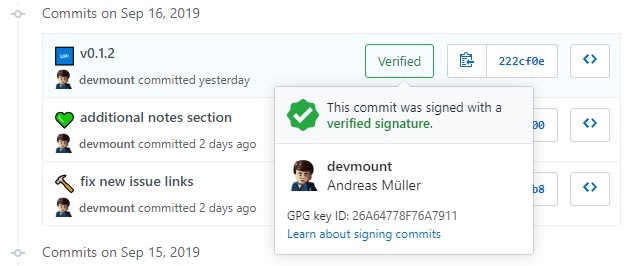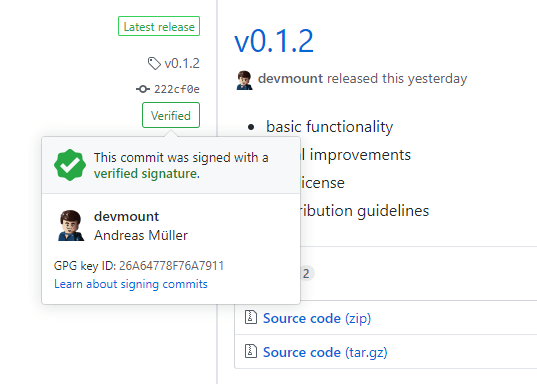The time had come to fix something that had been bugging me for a long time: Still making unsigned Git commits from VS Code.
TL;DR: Add "git.enableCommitSigning": true to settings.json of VS Code* after configuring your singing key ID and upload your public GPG key to your Git server.
I am a fan of green badges. Wherever possible, I’m trying to achieve them. I love when my browser shows the little green lock for websites served over HTTPS or when my taskbar shows the little green lock for an active VPN connection. Green badges indicate confidence and security. They give me the positive feeling, that the trustworthiness of someone or something was proved and certified. In times, where the Twitter account of Twitter CEO Jack Dorsey was hacked by simply duplicating his phones SIM card, it surely would be a good idea, to verify a tweet with more than just the senders phone number and reward a secure verification with a corresponding badge. So I try to provide as many green badges as possible for visitors, users and contributors of my work.
For most of my projects I use VS Code on Windows for creating and GitHub for publishing my code. The built-in Git integration in VS Code turned out to be extremely useful and fast for frequent Git commands. And now I wanted VS Code to sign my commits without additional effort or being interrupted to switch to the terminal.
Git supports signed commits for quite a while now (January 2012) and signed tags even longer. This means, Git provides the possibility to verify that commits are actually from a trusted source using the GNU Privacy Guard (GPG). GitHub marks signed commits with a green “verified” badge.
This is how it worked for me in VS Code on Windows:
Set up GPG
First you have to install GPG, if you don’t already have it. You can verify your installation (i.e. with Windows Power Shell) like this:
$ gpg --version
gpg (GnuPG) 2.2.17
libgcrypt 1.8.4
If your system doesn't know them yet, you have to import your public and private keys (I assume you have them stored in files called public.key and private.key). If you don’t have a key pair, you can generate a new one. In that case, you can skip the import and directly jump to Set up Git. It's also possible to use your Keybase GPG key, if you have one (Stephen Rees-Carter wrote a nice article about it).
gpg --import public.key
gpg --import private.key
Note: when importing the private key, a GUI window appears that asks for the corresponding passphrase you set when creating your key pair.
Set up Git
Now you can tell Git your signing key ID. It’s a 16-digit alphanumeric string that can be found with gpg --list-signatures (look for lines starting with “sig”).
git config --global user.signingkey 26A64778F76A7911
If you want, you can tell Git to sign commits per default (since Git 2.0), so you don’t always have to add the -s flag in the command line:
git config --global commit.gpgsign true
Note, that I use the --global flag here to apply these settings to all my local repositories. Of course you can apply these settings only to the current repository without it.
Set up GitHub
Now you have to give GitHub (or whatever Git server you’re using) your public key. You can print it with gpg --armor --export or get-content -path public.key (or open it with your favorite text editor) and copy it to your clipboard. Now go to GitHub, click on the top right menu, go to Settings > SSH and GPG keys > New GPG key and paste your key — it should look like this:
-----BEGIN PGP PUBLIC KEY BLOCK-----
...a lot of characters...
-----END PGP PUBLIC KEY BLOCK-----
If everything worked correctly, you should see your GPG key like this:

Set up VS Code
Finally you have to tell VS Code to append the -s flag to the git commit command, to use signed committing now. Open the settings, search for “gpg” and check the box “Enables commit signing with GPG”.
Alternatively you can add this line to your settings.json :
"git.enableCommitSigning": true
And that’s it! Now you can commit your changes in VS Codes Git integration and sign your work.
Note that you will be prompted for the passphrase of your private key at first.
Your commits now look like this in a GitHub repository under “commits”:

This badge also appears under “releases”, if the last commit of this release was signed:

Error: secret key not available
Well, would have been too easy if it worked at first try… unfortunately I had to deal with the following weird error message, that appeared always when I tried to commit using the -s flag:
$ git commit -am "a message" -s
gpg: skipped "26A64778F76A7911": secret key not available
gpg: signing failed: secret key not available
error: gpg failed to sign the data
fatal: failed to write commit object
After some research, I found, that I had to tell Git the path to the GPG executable (for whatever reason) using the git config pgp.program setting:
git config --global gpg.program "C:\Program Files (x86)\gnupg\bin\gpg.exe"
Note that the path may be a different one on your system.
After this, everything worked like a charm! Feel free to leave a comment, if you are facing other issues or you’d like to make me feel guilty because you already sign your commits for years :)
Edited: 2nd July 2021 (added TL;DR paragraph)
Originally published: 18th September 2019 on Medium







Top comments (32)
Thank you so much for this post. Very good stuff
I didnt manage to do it myself, but thats probably just me and one day it will work ;)
Edit: Fixed.
I had to use GPG Keychain for mac os to make it work. ;)
You're welcome, glad I could help! And thanks for the GPG keychain hint!
Nice post. It would be nice to have TL;DR at the top of the post that just covered the following content:
Great suggestions - done. Many thanks (and sorry for the late reply - didn't see any notification about your comment).
Now I have my green badge on my commits, thank you! Good write( only the “import” section wasn’t clear to me ).
Nice 👏🏻!
And thank you for your feedback! Any suggestions how to improve the "import" part? I'll try to update it soon!
In reality, I haven’t to import nothing: after the key are created, go straight to “set up git” section; to setup GitHub, then, with the command gpg —armor —export you can copy/paste the public key to GitHub settings. Furthermore I discovered that git on windows came bundled with own gpg executable so, using your guide with git bash, the “Error: secret key not available” section is useless (git can commit without to declare the path because it uses its own). Last trick: you can leave the pass phrase blank so you don’t need to write it to commit. Ps: sorry for the formatting, I’m on mobile
Thank you Nicola, I've updated the post accordingly! The "import" part now covers the key creation case and
gpg --armor --exportcommand.Yes, if you don't have any issues with this error message, you don't have to specify the path. It was just meant for those, who are facing the same problem as I did.
I wouldn't recommend using a private key without a passphrase for security reasons. But yes, you're right: you don't have to use a passphrase.
Make sure to look up the discussion around whether you should auto-sign or not.
Linus Torvalds for instance is against it.
I personally do auto-sign my own work.
Just suggesting that you look into the discussion and make your decision.
Thank you Anthony for your suggestion!
I found this thread where Linus describes his opinion about auto-sign commits. But I'm not really sure I understood his point correctly... For me it sounds more that he argues for a different use case: the verification of the integrity of a release (git tags) or entire project. For me it's more about verifying the authorship of single commits.
Updated link web.archive.org/web/20210412010515...
The one problem I've come upon is on Mac, if you haven't put your passphrase in for a while, VSCode doesn't prompt you for your password, you have to commit from the terminal. This is solved by using GPG Suite, as it permanently caches your credentials, but without using this you're unable to commit every ~2 hours from the interface and have to use the terminal.
Otherwise, great post.
Thank you for this addition 👏🏻
This kind of article is exactly what I expect to find on this platform: something which is supplementing documentation by adding some specific case studies (i.e. your last part about unavailability of secret key).
That being said, to come back to the subject, once the key has been created and the VSC editor settings have been properly configured, the recurring appearance of the Pinentry dialog window in order to type passphrase each time you are ready to commit something is particularly annoying (and it doesn't seem easy to define an convenient storage of this password currently).
Thank you for your comment (I didn't get notified about it, seems like this is a general issue on dev.to for new comments on old articles)! I'm totally with you here - though you get used to it at some point, it's nevertheless additional effort.
I see if I can find a convenient way to save this password on a trusted device. I will update the article accordingly if I found something.
For me, I had to add a Carriage Return after -"----BEGIN PGP PUBLIC KEY BLOCK-----" and before "-----END PGP PUBLIC KEY BLOCK-----" to get it to work, but otherwise killer write up Fam! Thank you for this! ❤💯
Good article! Though I don't know if I'm understanding the subject incorrectly but I think the
git commitflag needed to sign (in the sense of using you gpg keys to sign the commit) is-Sand not-s. I'm assuming that the"git.enableCommitSigning": trueoption is adding-Scorrectly. My git man pages reads:That's pretty cool, I need to get mine setup. Awesome read!
Thank you 😊! I'm glad this post is useful for you!
Thanks for this guide. i guess i don't have to make the same post i will share it. i have been using this feature on my account but a few week ago i came across a problem where every time i want to push changes to my repo it gives me this error:
i have to use the terminal and include
for any push to work and it keeps my green badge status
any help on this guys.
Thanks for you help.
Pretty cool thanks a lot
You're welcome 😊! Happy to see that it's useful!
just Created an account to come and thank you for the awesome article👍
keep up the good stuff❤
You're very welcome 🤗 Will do!
Thanks for the guide. I have also written my 1st technical guide on the same topic with detailed screenshots for Windows and Gitlab - link.medium.com/LqSLButvuab
Thank you very much!
nice to read and very useful!